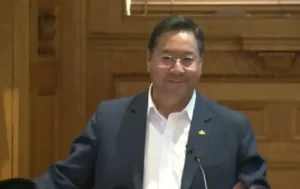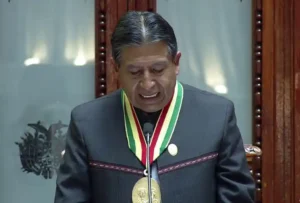Bolivia has had a rich and complex political history since gaining independence from Spain in 1825. Let’s take a journey through time and explore the leaders who have shaped this South American nation.
The First President of Bolivia: Simón Bolívar
Before we dive into our table of presidents, let’s talk about the man who started it all – Simón Bolívar. Known as “El Libertador” (The Liberator), Bolívar was a Venezuelan military and political leader who played a crucial role in Latin America’s independence movement from Spain.
Bolívar became Bolivia’s first president in 1825, shortly after the country declared independence. However, his tenure was brief, lasting only a few months. Despite this short time in office, Bolívar’s impact on Bolivia was immense. He’s considered the founding father of the nation, which is even named after him!
Now, let’s take a look at the full list of Bolivia’s presidents:
SEE ALSO: Presidents That Have Ruled Brazil Till Date
| President | From | To |
|---|---|---|
| Simón Bolívar | 1825 | 1826 |
| Antonio José de Sucre | 1826 | 1828 |
| Andrés de Santa Cruz | 1829 | 1839 |
| José María de Achá | 1839 | 1841 |
| Ramón Castilla | 1841 | 1842 |
| José Ballivián | 1841 | 1847 |
| Manuel Isidoro Belzu | 1848 | 1855 |
| Jorge Córdova | 1855 | 1857 |
| Mariano Melgarejo | 1864 | 1871 |
| Agustín Morales | 1871 | 1872 |
| Hilarión Daza | 1876 | 1879 |
| Nicolás Suárez | 1879 | 1880 |
| Ciriaco de la Vega | 1880 | 1884 |
| Aniceto Arce | 1884 | 1888 |
| Severo Fernández | 1888 | 1896 |
| José Manuel Pando | 1899 | 1904 |
| Ismael Montes | 1904 | 1909 |
| Eliodoro Camacho | 1909 | 1913 |
| José Gutiérrez Guerra | 1913 | 1917 |
| Victorio Salinas | 1917 | 1920 |
| Bautista Saavedra | 1920 | 1921 |
| Enrique Peñaranda | 1921 | 1925 |
| Felipe Segundo Guzmán | 1925 | 1926 |
| José Luis Tejada Sorzano | 1926 | 1930 |
| Daniel Salamanca | 1931 | 1934 |
| José David Rodríguez | 1934 | 1936 |
| Germán Busch | 1937 | 1939 |
| José Luis Tejada Sorzano | 1939 | 1943 |
| Gualberto Villarroel | 1943 | 1946 |
| Enrique Peñaranda | 1946 | 1947 |
| Mamerto Urriolagoitia | 1947 | 1949 |
| Hugo Ballivián | 1949 | 1951 |
| Víctor Paz Estenssoro | 1952 | 1956 |
| Hernán Siles Zuazo | 1956 | 1960 |
| Eduardo Avaroa | 1960 | 1964 |
| René Barrientos | 1964 | 1969 |
| Juan José Torres | 1969 | 1970 |
| Hugo Banzer | 1971 | 1978 |
| Walter Guevara | 1979 | 1980 |
| Luis García Meza | 1980 | 1981 |
| Hernán Siles Zuazo | 1982 | 1985 |
| Víctor Paz Estenssoro | 1985 | 1989 |
| Gonzalo Sánchez de Lozada | 1993 | 1997 |
| Hugo Banzer | 1997 | 2001 |
| Jorge Quiroga | 2001 | 2002 |
| Evo Morales | 2006 | 2019 |
| Jeanine Áñez | 2019 | 2020 |
| Luis Arce | 2020 | Present |
The Current President of Bolivia: Luis Arce

Now, let’s talk about Bolivia’s current leader. Luis Arce took office on November 8, 2020, after winning the 2020 Bolivian general election. Arce, an economist by profession, previously served as Minister of Economy and Public Finance under former President Evo Morales from 2006 to 2017 and in 2019.
Arce’s presidency marks a return to power for the Movement for Socialism (MAS) party after the controversial resignation of Evo Morales in 2019. Arce has pledged to continue many of the socialist policies implemented during Morales’ tenure while also focusing on economic recovery in the wake of the COVID-19 pandemic.
The Current Vice President of Bolivia: David Choquehuanca

Serving alongside President Arce is Vice President David Choquehuanca. Choquehuanca is an Aymara politician and diplomat who previously served as Foreign Minister of Bolivia from 2006 to 2017 under Evo Morales.
Choquehuanca is known for his advocacy of indigenous rights and his promotion of the Andean concept of “Vivir Bien” or “Living Well,” which emphasizes harmony between humans and nature.
As we can see from this extensive list, Bolivia has had a complex political history with numerous leadership changes. From its independence in 1825 to the present day, the country has seen 76 different presidencies (including the current one), with some individuals serving multiple non-consecutive terms.
It’s worth noting that Bolivia’s political landscape has been marked by periods of stability interspersed with times of frequent change.
For instance, the country saw relatively long presidencies in the early 20th century, such as those of Ismael Montes and Hernando Siles Reyes. In contrast, there were periods of rapid turnover, particularly in the late 1970s and early 1980s, reflecting the political instability of those years.
The presidency of Evo Morales from 2006 to 2019 stands out as one of the longest continuous terms in Bolivia’s history. His tenure saw significant changes in the country’s political and economic landscape, including the adoption of a new constitution in 2009.
As Bolivia moves forward under the leadership of President Arce and Vice President Choquehuanca, the country continues to grapple with challenges such as economic development, social inequality, and environmental conservation. The legacy of past leaders and the policies they implemented continue to shape Bolivia’s present and future.
